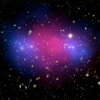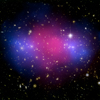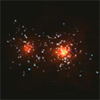CXC Home | Search | Help | Image Use Policy | Latest Images | Privacy | Accessibility | Glossary | Q&A
Tour of MACS J0025.4-1222
Quicktime MPEG
Two galaxy clusters, each a quadrillion times the mass of the Sun, collided to form the system formally known as Macs J0025.4-1222. When these clusters merged at speeds of millions of miles per hour, the hot gas in each cluster collided and slowed down, but the dark matter in each system did not. Optical images from Hubble were used to infer the distribution of the total mass, which includes dark matter, using a technique known as gravitational lensing. This is seen as blue in the image. Chandra data enabled astronomers to accurately map the position of the ordinary matter, mostly in the form of hot gas, which glows brightly in X-rays and is colored pink in the composite. The separation between the pink and the blue provides direct evidence for the existence of dark matter.
In some ways, Macs J0025 can be thought of as a prequel to the famous system known as the Bullet Cluster. At a much larger distance of 5.7 billion light years, astronomers are witnessing this collision that occurred long before the Bullet Cluster. This finding is important because it independently verifies the results found for the Bullet Cluster in 2006, and shows once again that dark matter is real.
[Runtime: 01:25]
Quicktime MPEG
Two galaxy clusters, each a quadrillion times the mass of the Sun, collided to form the system formally known as Macs J0025.4-1222. When these clusters merged at speeds of millions of miles per hour, the hot gas in each cluster collided and slowed down, but the dark matter in each system did not. Optical images from Hubble were used to infer the distribution of the total mass, which includes dark matter, using a technique known as gravitational lensing. This is seen as blue in the image. Chandra data enabled astronomers to accurately map the position of the ordinary matter, mostly in the form of hot gas, which glows brightly in X-rays and is colored pink in the composite. The separation between the pink and the blue provides direct evidence for the existence of dark matter.
In some ways, Macs J0025 can be thought of as a prequel to the famous system known as the Bullet Cluster. At a much larger distance of 5.7 billion light years, astronomers are witnessing this collision that occurred long before the Bullet Cluster. This finding is important because it independently verifies the results found for the Bullet Cluster in 2006, and shows once again that dark matter is real.
[Runtime: 01:25]
(Credit: X-ray (NASA/CXC/Stanford/S.Allen); Optical/Lensing (NASA/STScI/UC Santa Barbara/M.Bradac))
Chandra and Hubble Images of Cluster Collision
Quicktime MPEG
Two galaxy clusters, each a quadrillion times the mass of the Sun, collided to form the system known as MACS J0025.4-1222. When they merged at speeds of millions of miles per hour, the hot gas in each cluster collided and slowed down, but the dark matter did not. Optical images from Hubble were used to infer the distribution of the total mass -- dark and ordinary matter -- using a technique known as gravitational lensing (blue). Chandra data enabled astronomers to accurately map the position of the ordinary matter, mostly in the form of hot gas, which glows brightly in X-rays (pink.) The separation between the material shown in pink and blue provides direct evidence for dark matter.
[Runtime: 00:17]
Quicktime MPEG
Two galaxy clusters, each a quadrillion times the mass of the Sun, collided to form the system known as MACS J0025.4-1222. When they merged at speeds of millions of miles per hour, the hot gas in each cluster collided and slowed down, but the dark matter did not. Optical images from Hubble were used to infer the distribution of the total mass -- dark and ordinary matter -- using a technique known as gravitational lensing (blue). Chandra data enabled astronomers to accurately map the position of the ordinary matter, mostly in the form of hot gas, which glows brightly in X-rays (pink.) The separation between the material shown in pink and blue provides direct evidence for dark matter.
[Runtime: 00:17]
(Credit: X-ray (NASA/CXC/Stanford/S.Allen); Optical/Lensing (NASA/STScI/UC Santa Barbara/M.Bradac))
Animation of Galaxy Cluster
Quicktime MPEG
This animation shows a galaxy cluster, the largest gravitationally-bound objects in the Universe. Two of these mammoth objects collided to create the system that astronomers call MACS J0025.4-1222. Individual galaxies are shown in white and yellow, and the intergalactic gas is shown in red. Galaxy clusters contain as much mass as a million billion suns. The strong gravitational pull of this matter squeezes the gas and heats it to about 100 million degrees, making it only detectable in X-rays.
[Runtime: 00:38]
Quicktime MPEG
This animation shows a galaxy cluster, the largest gravitationally-bound objects in the Universe. Two of these mammoth objects collided to create the system that astronomers call MACS J0025.4-1222. Individual galaxies are shown in white and yellow, and the intergalactic gas is shown in red. Galaxy clusters contain as much mass as a million billion suns. The strong gravitational pull of this matter squeezes the gas and heats it to about 100 million degrees, making it only detectable in X-rays.
[Runtime: 00:38]
(Credit: NASA/CXC/A.Hobart)
Return to MACS J0025.4-1222 (Aug 27, 2008)





